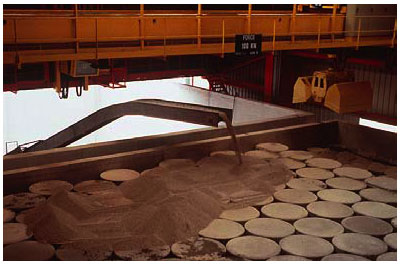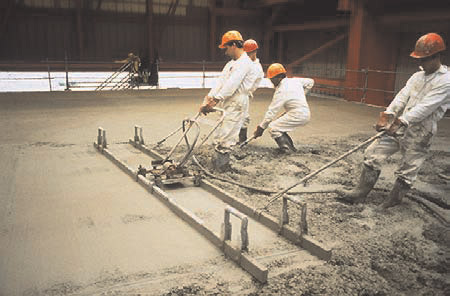Disposal of low and intermediate-level short-lived waste
Low and intermediate-level short-lived waste (LILW-SL) is one of the two categories of radioactive waste for which an operational above-ground final disposal exists. The other is very low-level waste (VLLW). These two categories are the least radioactive, but the tonnages involved are by far the greatest. They pose the least risk to the environment, as the radioactive atoms concerned have relatively short half-lives and are not very abundant in the waste packages.

Waste stacking phase
This photograph shows drums of waste stacked in concrete cells at the CSA waste repository. When a layer is full, the gaps between waste packages are filled with mortar, in cells containing metal drums, and with gravel in cells containing cement-filled drums.
© ANDRA (Source: ANDRA/Michel Dutzer)
An operational waste repository: In France, LILW-SL waste was the first category for which a final repository was built. From 1969 to 1994, such waste was disposed of at the CSM final repository located in Digulleville, very close to the plant in La Hague. This facility is now full. The facility entered the regulatory monitoring phase following its closure.
When the site was closed in 1994, a new waste repository in Soulaines, also in the Aube department, took over its previous role: the Centre de Stockage de l’Aube (CSA). This repository is located on clay ground, which is the most advantageous for a repository.
The CSA facility has a capacity of 1 million cubic metres. Forecasts indicate that it will take around 50 years to fill it.

LILW waste repository in the Aube department (CSA)
Low- and intermediate-level short-lived waste is disposed of at the CSA LILW repository. At this facility, metal containers from small waste producers are stacked in layers in concrete repository cells. The gaps between drums in each layer are filled with cement slurry. When a repository cell is full, it is permanently sealed with cement.
© ANDRA
Annual production of LILW-SL (including packages) totals around 15,000 m3; this volume has fallen steadily as a result of the efforts undertaken by producers. The source of most of the waste is the nuclear industry and nuclear research sector: 56% from power plants, 17% from research conducted at the Atomic Energy Commission (CEA), 25% from fuel manufacturing and reprocessing plants (the latter figure corresponding to dismantling activities of the facilities in Marcoule). Only 2% of the waste is from small producers.
It was decided to use remote handling systems, to reduce operator exposure doses. As a result, the types of waste containers were standardised. In all, 12 types of waste package are used: four types of metal drum, two metal boxes, four fibre cement drums and two concrete boxes. The volume of these standard waste packages varies from a few hundred litres to around 10 cubic metres. Some waste is incinerated (contaminated clothing) or smelted (metal parts) at a specially-designed facility near Marcoule prior to disposal.
ANDRA video about the CSA waste repository
ANDRA stacks waste packages in reinforced concrete cells. When a cell has been filled, the gaps are filled with gravel or mortar and the cell is sealed with a concrete slab and coated with a waterproofing polymer sealant. When the time is right, a watertight cover will be applied and the site covered with a few metres of earth.
Another ANDRA video about the Aube waste repository: View video
ALSO : Early waste disposal facilities
Learn more :
Low- and intermediate-level waste
Low and very low level waste
ANDRA : Centre de Stockage de l’Aube (CSA)
Other articles on the subject « Waste management »
Waste management status
Repositories already in operation for low-level waste Compared with other types of waste, the mas[...]
Other storage facilities
Interim waste storage according to their nature and origin Spent fuel and vitrified waste from Pr[...]
Temporary storage
A temporary solution Interim storage is a temporary solution that plays a central role in the man[...]
Vitrified waste Storage
Dry storage of vitrified waste Spent nuclear fuel assemblies are not the only materials removed f[...]
Spent fuel storage
Interim storage in pools and then dry locations In all countries, spent fuel management begins wi[...]
Management outside France
Overview of waste management strategies outside France Management of the least radioactive waste [...]
VLLW repository
An operational repository for very low-level waste The second category of waste for which a repos[...]
High level waste transportation
Moving highly radioactive materials The 10% of transport movements that concern high-level radioa[...]
Transport safety
Measures to ensure safe transport Nuclear materials may be highly radioactive. The goal is to pre[...]
Transport-related incidents
Incidents but no accidents… Have radioactive material transport operations caused any accid[...]